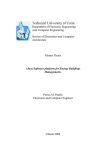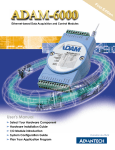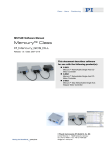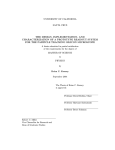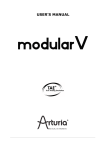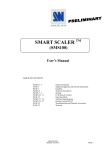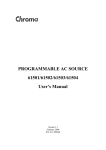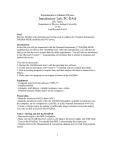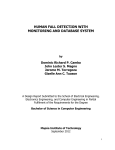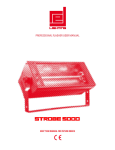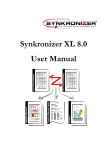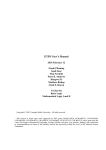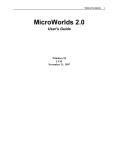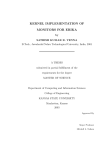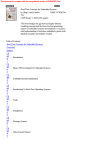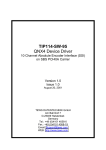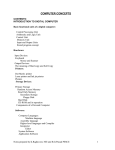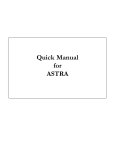Download System and method for automatically creating source code example
Transcript
US006237136B1
(12) United States Patent
(10) Patent N0.:
(45) Date of Patent:
Sadahiro
(54)
SYSTEM AND METHOD FOR
OTHER PUBLICATIONS
AUTOMATICALLY CREATING SOURCE
(75)
US 6,237,136 B1
*May 22, 2001
_
_
_
CODE EXAMPLE FILES FOR AN
BraZ1le.A System for Program Component Spci?cation and
GP PROGRAMMING LANGUAGES
Castelluccia et al. Generating Ef?cient Protocol Code From
an Abstract Speci?cation. ACM. pp. 514—524, Aug. 1997.*
Inventor:
* cued by exammer
Ken Sadahiro, Austin, TX (US)
Primary Examiner—Kakali Chaki
.
_
.
,
Assistant Examiner—Wei Zhen
(73) Asslgnee' iatl9na%)l(nsggments Corporatlon’
usnn’
(
(74) Attorney, Agent, or Firm—Conley, Rose & Tayon PC;
)
Jeffrey C. Hood
(57)
(*)
Notice:
ABSTRACT
This patent issued on a continued pros
ecution application ?led under 37 CFR
153((1), and is Subject to the twenty year
patent term provisions of 35 U_S_C_
154(21)(2)_
A system and method for generating source code example
?les for an application program in a computer system. In the
preferred embodiment, the system and method is used for
creating source code example ?les for the NI-DAQ driver
softWare from National Instruments. The user ?rst generates
Subject to any disclaimer, the term of this
patent is extended or adjusted under 35
a code ?oW description ?le. The code ?oW description ?le is
Written in a code ?oW description language Which is inde
U.S.C. 154(b) by 0 days.
pendent of a plurality of programming languages, i.e., Which
includes only common programming elements from the
<21)
<22)
(51)
(52>
<58)
APPL NO; 08/982,592
plurality of programming languages. The user then speci?es
Filed:
Dec- 2, 1997
Int. Cl.7 ...................................................... .. G06F 9/45
one or more target programming languages. The present
invention includes a Code Generator Which generates one or
more target example Source Code ?les in the Speci?ed target
717/2 717/1_ 717/3
programming languages in response to the code ?oW
_
’
Fleld of Search ................................... ..
’
description ?le. The Code Generator operates to parse the
Code ?OW description ?le to produce a Code ?OW description
717/2’ 3’ 1
data structure, and then generate the one or more target
example source code ?les in the speci?ed target program
,
(56)
References Clted
ming languages in response to the code ?oW description data
[)3 PATENT DOCUMENTS
structure. The user can thus easily create a number of source
code example ?les for a plurality of different programming
4,827,404 : 5/1989 Barstow et a1. ................... .. 395/500
languages and/OI. for a plurality of different Operating sys_
5,159,687
terns‘
5,187,788 *
10/1992 Richburg .~........ ..
2/1993 Marmelstein
5,675,801 * 10/1997
6,070,007 *
Lindsey ....... ..
395/702
395/703
395/702
5/2000 Simonyi ............................. .. 395/702
39 Claims, 7 Drawing Sheets
User creates
code Ilow
description file
l
Code generator parses
code ?ow description
file to produce code
?ow UQSCHDHOI'I data
structure
@
1
Verify code
?ow data structure
%
1
Code generator
generates a target
source code tale 0! an
example in response to
code flow data structure
1
Code generator
generates target
documents
m
U.S. Patent
May 22, 2001
Sheet 1 0f 7
US 6,237,136 B1
U.S. Patent
May 22, 2001
Sheet 2 0f 7
Code-H9”
US 6,237,136 B1
Code Generator
Descnptlon ____>
File
204
Q2
—
Fig. 2
Nl-DAQ
Function
database
C d
'
Pro ram Flow
0 9
gEditor
Generator
""" "réad'ikif'amm
"1555f taagge'raaé‘n‘t'“
'l'ah'gl'i‘riaébéhééréi'
E
2B
295
Doc DB
m
tools
prototypes
code
flow DB
E
E2
Fig. 3
*includes CVI
U.S. Patent
May 22, 2001
Sheet 3 0f 7
US 6,237,136 B1
1 . Emmi‘; the 'faimwing“...
{1W8 HEW EHIRHBEQ F?i?l
gi’utm?.lliiif??gé?'i .................................. ..
$1"
"
Q?l‘é?'f an agparatim and an
Hi8:
Tmgm:
Baum:
i‘? EFHE Listing
51mm‘? NEFEQE
U.S. Patent
May 22, 2001
Sheet 4 0f 7
4
US 6,237,136 B1
U.S. Patent
May 22, 2001
Sheet 5 0f 7
User creates
code flow
description file
Q
1
Code generator parses
code ?ow description
file to produce code
flow description data
structure
?ll
l
Verify code
flow data structure
@
V
Code generator
generates a target
source code file of an
example in response to
code flow data structure
§_Q_8_
1
Code generator
generates target
documents
@
Fig.6
US 6,237,136 B1
U.S. Patent
May 22, 2001
@8E95 :69
5:0_8i@936:26=630w>9
2 :682502.;9:
Sheet 6 6f 7
US 6,237,136 B1
NOE
co?ée
zm O
I02“.Z25 8
.65c29s5iw
52m95V
zom g s w
@30:Emuo
L22$5082 2@5632 98 é$52E5S6:E2
mwm
mo mw
2Q56ES9
U.S. Patent
May 22, 2001
Sheet 7 0f 7
US 6,237,136 B1
~~immpéia Satay“?
" “ample: mm WW5 >
1-27. m.
._
List 271mm.Fmww‘inWWI-"W _ *
Emma-mien ilnf?rmatim
mm‘
??zmnlesl'tl-jmuir-ahaiag‘s?gn‘ai
22mg @217 152-11982.‘ i111
shame;
- " " '1'.
'
'
[I '
" f?ré?auii
'an'afziag
' '
imam‘' media fm'
'
this~
if;
US 6,237,136 B1
1
2
SYSTEM AND METHOD FOR
AUTOMATICALLY CREATING SOURCE
CODE EXAMPLE FILES FOR AN
APPLICATION PROGRAM IN A PLURALITY
OF PROGRAMMING LANGUAGES
Were required to be upgraded due to compatibility issues.
Also, each example used slightly different sequences of
function calls, Which required that support personnel knoW
the subtle differences betWeen the examples. Fourthly, the
siZe of the executables and/or run-time engines (eg the
RESERVATION OF COPYRIGHT
Visual Basic 3.0 run-time DLL is over 700 kB) required to
run the executables required increased amounts of disk
A portion of the disclosure of this patent document
contains material to Which a claim of copyright protection is
the examples included no information on hoW physical
signals Were to be connected to the data acquisition devices
made. The copyright oWner has no objection to the facsimile
space for the installation media (1.44 MB ?oppies). Fifthly,
10
While being used With these examples.
reproduction by anyone of the patent document or the patent
Finally, customers typically requested “code snippets”,
disclosure as it appears in the Patent and Trademark Of?ce
patent ?le or records, but reserves all other rights Whatso
Which are concisely Written source code ?les shoWing hoW
to perform a certain task. The customer support engineers
ever.
15
BACKGROUND
required maintenance for the example source code, appli
1. Field of the Invention
The present invention relates to a system and method for
automatically generating source code example ?les for an
application program, Wherein source code example ?les are
cation developers Were reluctant to provide a large number
of examples to the users. The NI-DAQ library is a versatile
driver library Which supports over 50 different DAQ devices
and signal conditioning units, as Well as a Wide variety of
tasks for each DAQ device. Although the NI-DAQ User
Manual did explain in How charts hoW to use the set of
automatically generated for a plurality of different program
ming languages and/or a plurality of different operating
systems.
2. Description of the Related Art
Many application programs are distributed With examples
Which illustrate or exemplify operation of the application
program. In many instances, the application program
includes examples in a number of different programming
25
languages. For example, NI-DAQ, the device driver and
easily generating example programs for an application
program, preferably in a plurality of different programming
languages and/or for a plurality of different operating sys
Acquisition (DAQ) devices, is generally distributed With
tems.
35
generally had the folloWing characteristics. First, each
data acquisition parameters While running the example pro
gram. Second, each example accommodates a Wide variety
of DAQ devices. HoWever, not all devices Were supported
Instruments.
The developer ?rst generates a code ?oW description ?le.
by all NI-DAQ functions. Therefore, each example imple
The code ?oW description ?le is Written in a code ?oW
45
(OS) versions (3.1x, 95, and NT), each taking advantage of
the programming language speci?c features through lan
description language Which is independent of a plurality of
programming languages, i.e., Which includes only common
programming elements from the plurality of programming
languages. The developer then speci?es one or more target
programming languages. The present invention includes a
guage and OS speci?c project ?les. Finally, each example
Code Generator Which generates one or more target example
Was delivered in the form of source code and ready-to-run
executables.
source code ?les in the speci?ed target programming lan
guages in response to the code ?oW description ?le. The
Code Generator operates to parse the code ?oW description
?le to produce a code ?oW description data structure, and
While each delivered example illustrated an important
aspect of using the NI-DAQ dynamic link library (DLL)
through the exported application programming interface
(API) calls, they had the folloWing shortcomings With
SUMMARY OF THE INVENTION
The present invention comprises a system and method for
generating example source code ?les for an application
program in a computer system. In the preferred embodiment,
the system and method is used for creating source code
example ?les for the NI-DAQ driver softWare from National
example included extensive WindoWs graphical user inter
face (GUI) code, so that the user could easily change key
mented run-time branching to make device speci?c function
calls. Thirdly, each example Was Written individually for
each language and three different WindoWs operating system
NI-DAQ functions to perform various basic data acquisition
tasks, the nature of the API calls required detailed expertise
When it came to programming. Without examples, customers
had a very dif?cult time programming With the NI-DAQ
function calls.
Therefore, an improved system and method is desired for
WindoWs driver library set for National Instruments Data
code examples in Microsoft Visual C++, Microsoft Visual
Basic, and Borland C++.
In the NI-DAQ application program, the code examples
Were thus required to spend time Writing these short
examples for customers.
Due to the above shortcomings and the large amount of
55 then generate the one or more target example source code
?les in the speci?ed target programing languages in
respect to the above mentioned characteristics. First, it Was
very dif?cult to ?nd the feW NI-DAQ function calls located
in the feW hundred lines of GUI code. In one example, there
Were 340 lines of code, Which only included 2 lines of
response to the code ?oW description data structure.
In one embodiment, the system further includes a pro
NI-DAQ function calls. Thus the NI-DAQ programming
example resembled a WindoWs programming tutorial.
system further comprises a function database Which stores
functions of the application program Written in the code ?oW
Secondly, When the NI-DAQ driver set Was upgraded to
include support for neW data acquisition (DAQ) devices, a
description language. The function database is useable in
creating the code ?oW description ?le.
Thus, one object of the present invention is to easily
gram editor for creating the code ?oW description ?les. The
programmer had to maintain the different versions of the
examples for each programming language and OS. Thirdly,
When a neW version of the programming language Was
released (e.g.: Microsoft Visual C++ 5.0), the project ?les
65
create a large collection of examples that illustrate only a
single basic data acquisition task, and reduce GUI code to a
bare minimum.
US 6,237,136 B1
3
4
Another object of the present invention is to have all of
the examples of the same basic data acquisition task call the
e.g., ?oppy disk(s) or a CD-ROM, a system memory and/or
same sequence of NI-DAQ functions, so that an end user can
puter programs according to the present invention are stored.
In the preferred embodiment, the present invention com
prises a softWare program stored on the memory and/or hard
drive of the computer 100 and executed by the CPU. The
CPU executing code and data from the memory thus com
prises a means for executing the steps described beloW. The
computer system 100 may thus be used to create source code
example programs or ?les according to the present
invention, as described beloW.
a non-volatile memory, e.g., a hard drive, on Which com
examine an example in one language (e.g. Visual C++), and
expect the same exact functionality from a counterpart
example Written in another programming language (e.g.
Visual Basic).
Another object of the present invention is to simplify the
programming style of example programs to accommodate a
Wide range of programming expertise levels among end
10
users.
FIG. 2—SoftWare Components
FIG. 2 illustrates the softWare components comprising the
system and method of the present invention. As shoWn, the
Another object of the present invention is to create source
code program ?les Which provide suf?cient and consistent
documentation elements in the example source code itself
regarding What the example does, What functions it uses, its
key parameters, and What signal connections to the DAQ
15
description language. The code ?oW description ?le 202
speci?es the example to be created in a pre-de?ned format,
i.e., the code ?oW description language. The code ?oW
description language is preferably a generic to a plurality of
device are necessary. It is also an object to alloW comments
in the source code to explain any special tips and techniques
in that part of the source code.
different programming languages and/or operating systems.
Another object of the present invention is to reduce the
Stated another Way, the code ?oW description language
storage space required by the installation media by provid
incorporates the core or common programming constructs
ing only the ?les necessary to compile the source code into
from each of the a plurality of different programming
executable programs, but not the executables themselves.
Another object of the present invention is to maintain the
example code How in a single database ?le for ease of
maintenance, so that the single database ?le could then be
used to generate other types of ?les, such as on-line help
documentation, ?le lists, etc.
languages. The syntax of the code ?oW description language
25
is discussed in greater detail beloW.
Once the user creates the code ?oW description ?le 202,
the code ?oW description ?le is provided to a Code Gen
erator 204. The Code Generator 204 analyZes the code ?oW
description ?le 202 and is operable to create one or more
source code examples in selected programming languages
and/or for selected operating systems. In FIG. 2, the
examples shoWn comprise the Code Generator 204 gener
ating C source code example programs for Visual Basic,
LabWindoWs CVI, Microsoft Visual C++, Borland C++, and
BRIEF DESCRIPTION OF THE DRAWINGS
A better understanding of the present invention can be
obtained When the following detailed description of the
preferred embodiment is considered in conjunction With the
folloWing draWings, in Which:
user creates a code ?oW description ?le 202 in a code ?oW
35 an RTF ?le.
As discussed further beloW, in the preferred embodiment
FIG. 1 illustrates a computer system utiliZing the present
the present invention;
the Code Generator 204 operates to parse the code ?oW
description ?le to create a code ?oW data structure. The
Code Generator 204 then operates to convert the code ?oW
data structure into each of the different examples for the
FIG. 3 illustrates various softWare components comprised
in the preferred embodiment of the present invention;
different programming languages. This conversion utiliZes
the speci?c syntax rules required for each of the speci?c
invention;
FIG. 2 illustrates the operation of the code generator of
programming languages.
FIG. 4 is a screen shot illustrating use of the generator
In the preferred embodiment the code ?oW description ?le
according to the present invention;
FIG. 5 illustrates operation of the end user selecting target
source code example ?les for installation created using the
45
present invention;
ing code ?oW data structures for each segment. The Code
Generator 204 then operates to convert the code ?oW data
structures into each of the different examples for the differ
FIG. 6 is a ?oWchart diagram illustrating operation of the
present invention;
FIG. 7 is a state machine illustrating operation of the
ent target programming languages.
parsing method utiliZed by the code generator; and
FIG. 3—SoftWare Components of the Preferred Embodi
FIG. 8 illustrates an online help ?le created using the
ment
present invention.
DETAILED DESCRIPTION OF THE
PREFERRED EMBODIMENT
55
invention further includes a program How editor 212 Which
utiliZing the code ?oW description language.
Referring noW to FIG. 1, an illustrative computer system
and a poWer supply. The computer system 100 preferably
includes a memory media, such as an installation media,
FIG. 3 illustrates a preferred embodiment of the inven
tion. In FIG. 3, the system and method of the present
is useable for creating code ?oW description ?les 202
100 Which is programmed according to the present invention
and Which operates according to the present invention is
shoWn. The computer system 100 preferably comprises a
video display screen 102, a keyboard 104, and a mouse 106
as shoWn. The computer system 100 also includes various
standard components, including at least one central process
ing unit (CPU), a memory, a hard drive, one or more buses,
includes a plurality of code ?oW segments or records. The
Code Generator 204 operates to parse the code ?oW seg
ments in the code ?oW description ?le to create correspond
The system and method preferably also includes a func
tion database 214 Which stores code ?oW segments for
65
functions currently available in the application program for
Which examples are being created. The function database
214 comprises a database of functions Written in the code
?oW description language Which are used by the program
How editor in creating code ?oW description ?les. Since it is
presumed that these functions Will be repetitively used in
each of the code ?oW description ?les being created, the
US 6,237,136 B1
5
6
database 214 is provided to help the user to insert these
In the preferred embodiment, Where the application pro
gram is the NI-DAQ driver level softWare, the present
functions, pre-Written in the code ?oW description language,
directly into a code ?oW description ?le being generated.
This simpli?es development of the code ?oW description
?les. Also, if the application program function changes in
invention alloWs the creation of a large collection of
examples that illustrate a single basic data acquisition task
and Which also reduces GUI code to a minimum.
the future, it is only necessary to replace the function
The present invention also operates to make all examples
database 214. This alloWs additional reuse of existing code
?oW description ?les. In one embodiment, the program
editor includes search and replacement tools for search and
of the same basic data acquisition task call the same
sequence of functions, such as NI-DAQ functions. Thus, an
end user can examine the example in one language, e.g.,
Visual C++ and expect the same exact functionality from a
replacement of certain function calls, and thus existing code
?oW description ?les are not rendered obsolete When the
function database 214 changes.
counterpart example Written in another programming
language, e.g., Visual Basic. Thus, the present invention
provides consistency in examples over a plurality of differ
The function database 214 receives information from a
Documentation Database 218 Which describes other current
information relative to the application program. The Docu
mentation Database 218 contains a list of functions exported
15
by the application program. The Documentation Database
218 comprises function names, parameters, types, parameter
ent programming languages.
The present invention further simpli?es the programming
style in Which the example programs are Written to accom
lists, Whether or not a certain function is exported or not
modate a Wide range of programming expertise levels
exported, Whether or not it is documented, etc. This infor
mation is referenced by the Function Database 214 and is
among end users.
also used by the program How editor 212 in creating code
?oW description ?les.
Where the application program for Which examples are
being created is the NI-DAQ driver application from
National Instruments, the system and method preferably
The present invention ?sher provides suf?cient and con
sistent documentation elements in the example source code
itself regarding What the example does and the functions that
the example uses, as Well as its key parameters. For the
25
includes an NI-DAQ function database 214 Which stores
code ?oW segments for NI-DAQ functions available in the
current release of the NI-DAQ driver softWare. The NI-DAQ
function database 214 receives information from a document
database 218 Which describes other current information
relative to the NI-DAQ softWare. The program How editor
202 is operable to use the code ?oW segments in the function
database to form program code ?oW segments Within the
code ?oW description ?le. The Documentation Database 218
contains a list of functions that NI-DAQ exports.
NI-DAQ application program, the present invention also
provides documentation on What signal connections to the
DAQ device are necessary. Also, the present invention
inserts comments in the source code to explain any special
tips and techniques in their respective sections of the source
code.
The present invention further reduces the storage space
required by the installation media, since the present inven
tion enables the developer to provide only the ?les necessary
35
The code ?oW editor 202 further uses tools and prototypes
216 to aid in creating code ?oW description ?les. The
program How editor tools and prototypes 216 comprises a
to compile the source code into executable programs, and
thus does not require the executables themselves.
The system and method of the present invention is also
operable to maintain the example code ?oW description ?les
list of code ?oW de?nition segments or ?les Written for
functions that each example program may call, but Which are
in a single database ?le for ease of use and maintenance.
not necessarily part of the function database 214. For
instance, the set of examples contains a set of function calls
such as NI-DAQErrorHandler and NI-DAQDelay, Which
can also be used to generate other types of ?les such as
Further, this database of example code ?oW description ?les
online help documentation, ?le lists, etc.
FIG. 4—Screen Shot of the Examples Factory Code Gen
have their oWn prototypes. HoWever, these functions are not
erator
knoWn as NI-DAQ API functions and thus are not included 45
FIG. 4 is a screen shot of the Examples Factory Code
in the function database 214. Thus the tools and prototypes
216 alloWs the user to incorporate external functions, i.e.,
functions external to the application program, e.g., non-NI
Generator of the preferred embodiment. The Examples
Factory Code Generator reads in a code ?oW description
(CFD) ?le and generates different types of target ?les. As
shoWn, When the Code Generator is executed, the folloWing
options are speci?ed:
DAQ functions, into the code ?oW description ?le.
As shoWn, the program How editor 212 is used to create
a code ?oW description ?le 202. The code ?oW description
?le is then provided to the Code Generator 204 for creation
of the various example programs and/or documentation.
The present invention thus comprises a Code Generator
204 Which analyZes a code ?oW description ?le and is
operable to generate various example programs in selected
one Code FloW De?nitions File
one target directory—base directory Where the generated
?les Will be stored
55
programming languages and/or for selected operating sys
tems. The present invention further includes a novel code
?oW description language for creating code ?oW description
?les. The present invention further includes a program How
editor Which is used to aid in creating code ?oW description
?les. The present invention thus provides a suite of example
creation or generation tools Which are operable to easily
create example programs and documentation. The system
and method of the present invention are operable to create a 65
one target language—target programming language for gen
erated ?les
one operating system—target operating system for gener
ated ?les
type of target—source ?les, ?le listing, or examples spread
sheet ?le
After the above selections have been speci?ed, the user
clicks on the Do It! button to start generating the target ?les.
Code FloW Segments
The code ?oW de?nition ?le includes a collection of code
large collection of source code examples simply and ef?
?oW segments. A sample code ?oW segment appears as
ciently.
folloWs. (The syntax is explained in more detail later).
US 6,237,136 B1
8
-continued
1
* List of NI-DAQ Functions used in this example:
; 1ch 1pt — immediate
BeginCodeFlow
*
Filename: AIlPt
Descr: Read one channel, one point at a time, immediately
TaskIDList: 1PT, 1CH, IMMED
Category: AI
PinConnInfo: Connect your analog signal to AI channel 1. @
The default analog input mode for the DAQ device will be used.
:
:
:
:
:
:
I16, iStatus, 0, False
I16, iRetVal, 0, False
i16, iDevice, 1, False
I16, iChan, 1, True
I16, iGain, 1, False
F64, dVoltage, 0.0, False
*
*
* Pin Connection Information:
10 *
*
Connect your analog signal to AI channel 1. The default analog
input mode for the DAQ device will be used.
1
*
[For further I/O connection details, please refer to your hardware
*
User Manual.]
1
15 *
*
Var: I16, iIgnoreWarning, 0, False
iDevice
iChan
iGain
[NOTE: For further details on each NI-DAQ function, please refer
to the NI-DAQ On-Line Help (NIDAQPC.HLP).]
i
[For further details on how to run this example, please refer to
the NI-DAQ Examples On-Line Help (NIDAQEx.HLP).]
i
*******96****************************************************/
/*
Func: AIiVRead, iStatus
Param:
Param:
Param:
Param:
AIiVRead,NIDAQErrorHandler
i
* Includes:
20
*/
#include “nidaqex.h”
/*
dVoltage, *
* Main:
Func: NIDAQErrorHandler,iRetVal
*/
{
void main(void)
Param: iStatus
Param: “AIiVRead”
25
Param: iIgnoreWarning
* Local Variable Declarations:
Func: IF
Cond: iStatus, EQ, 0, LAST
30
Func: PRINT
{
i16
i16
i16
i16
i16
iStatus = 0;
iRetVal = 0;
iDevice = 1;
iChan = 1;
iGain = 1;
f64 dVoltage = 0.0;
i16 iIgnoreWarning = 0;
Param: The voltage at AI channel, CONST
Param: iChan, 116
iStatus = AIiVRead(iDevice, iChan, iGain, &dVoltage);
Param: is, CONST
Param: dVoltage, F64
Param: volts., CONST
iRetVal = NIDAQErrorHandler(iStatus, “AIiVRead”,
35
iIgnoreWarning);
if(iStatus == 0) {
printf(“ The voltage at AI channel %d is %If volts.\n”, iChan,
dVoltage),
Func: ENDIF
}
EndCodeFlow
40
If the user of the Examples Factory Code Generator
/* End of program */
As illustrated in the example above, since the source code
compiles into a “console” application, there are no compli
selects a C language (e.g. LabWindows/CVI, Microsoft
Visual C++, Borland C++) for any operating system, the
cated calls to set text in a graphical user display, instead a
code ?ow de?nition listed above is translated as follows.
Here note the common elements between the example below 45 simple, well understood printf call is used.
It is noted that, in the case of Visual Basic, where there is
and the code ?ow de?nition above.
a user interface by default, the Code Generator maps the
above print statement to print out to a prede?ned text box on
a Visual Basic form, and behaves very much like the printf
/*96*969696969696*96*96*96*9696*96*969696969696*9696969696*9696************************
50
i
The types of “Source” targets that can be generated in the
* Example program:
present embodiment are as follows:
Microsoft Visual C++ source code and MAKE ?le; (for
i
* Description:
* Read one channel, one point at a time, immediately
Windows 3.1: ver 1.5; for Win32 OSes: ver 2.0 and
55
1
Windows 3.1: ver 3.0; for Win32 OSes: ver 4.0)
Borland C++ source code and batch ?le (to help build the
AI
1
* Example Task Types:
1PT, 1CH, IMMED
e
above)
Microsoft Visual Basic source code and project ?le; (for
* Example Category:
*
statement in C.
application) (for version 5.0x)
60
National Instruments LabWindows/CVI (for version 3.0.1 or
later)
List of key parameters:
iChan
Microsoft Word Rich-Text Format (RTF) ?les that are to be
[Since variables are hardcoded, there is no guarantee that this
compiled into on-line help documentation
As shown in FIG. 4, for the “File listing” target type,
preferably only the Filename and Descr ?elds are extracted
program will work for your setup. This example is simply
presented as a code snippet of how you can use NI-DAQ functions
to perform a task.]
65
and placed into a single ?le. This ?lelist ?le is used as a
catalog that lists out brief descriptions of all the examples.
US 6,237,136 B1
9
10
Thus the end-user of the examples is not required to look
through each directory and open each example source code
to determine What the example does.
For the “Export to Notes DB” (spreadsheet) target, the
code ?oW description ?les can (theoretically) be up to 231
lines in length
The common elements to each code ?oW description are
the folloWing:
Filename, the NI-DAQ functions used, the Category, the
Keywords, and the target operating system are extracted and
placed into a single tab delimited, spreadsheet format ?le.
a
a
a
a
This spreadsheet ?le is preferably used by the developer of
the examples to match up examples With DAQ devices, and
is not intended for use by the end user.
example, denoted by TaskIDList:
10
FIG. 5—Packaging of the Examples for Distribution With an
a category in Which the example belongs, denoted by
Category:
Application Program
signal connection information to assist the end user of the
The products of the Examples Factory Code Generator
204 are preferably copied into a predetermined location
netWork drive location Where most application softWare ?les
are maintained (a.k.a. source tree). The ?les are then gath
code ?oW opener, denoted by BeginCodeFloW
Filename, denoted by Filename:
Description, denoted by Descr:
list of keyWords that describe the functionality of the
15
example in ?guring out hoW to connect physical signals to
the data acquisition device to make the program Work,
denoted by PinConnInfo:
a code block opener, denoted by an open curly bracket
ered by a separate installer creation process, so that the
examples can be distributed as part of the NI-DAQ distri
variable declarations, denoted by Var:
bution media (CD-ROM).
function calls and control How elements, Which are denoted
by Func: and have their oWn opener and closer curly
When the end-user receives the installation media to
brackets)
install the application program, e.g., NI-DAQ, and selects
“Third Party Compiler Support” from the installer option
a code block closer, denoted by a close curly bracket
a code ?oW closer, denoted by EndCodeFloW
The variable declaration syntax is as folloWs:
menu, as shoWn in FIG. 5, these examples, as Well as
supporting DLLs and ?les are installed in to the directory of
the end-user’s choice. (The installer is based on a separate
25
Var: <Type>, <Name>, <InitialValue>, <KeyParamT/F>,
install product.)
[ArraySiZe]
Code FloW De?nition Language Syntax and Composition
The <Type> ?eld speci?es the type of variable (i8, u8, i16,
Rules
u16, i32, u32, STRING).
According to the present invention, the developer ?rst
The <Name> ?eld speci?es the name of the variable.
The <InitialValue> ?eld speci?es the initial value of the
variable.
generates code ?oW description ?les Written in a code ?oW
description language. The present invention includes the
Code Generator 204, Which is operable to generate the
different target ?les based on the code ?oW description ?le,
Written in the code ?oW description language, and program
ming language speci?c rules. To ensure that all code ?oW
description elements can be mapped to features in each
The <KeyParamT/F> ?eld speci?es Whether this variable
35
programming language, the code ?oW description language
speci?ed.
preferably only uses or incorporates a bare minimum of the
The optional ?eld <ArraySiZe> indicates Whether the
feature set, e.g., the commonality of the feature set, of
variable name denoted by <Name> is an array or not. In the
case Where the variable is an array, the <InitialValue> ?eld
can be a common initial value for all array elements, or the
supported programming languages, such as:
only one code module per program, and one routine per code
module
variables declared locally inside the routine and alWays
assigned initial values at the beginning of the routine
very simple control How elements, such as if-elseif-endif,
While-end, do-While
very little support for simple arithmetic—increment and
is a “key parameter” in this program or not. That is, if the
value of this variable is changed, then the behavior of the
program Would change drastically. A “True” or “False” is
individual initial values can be speci?ed by a |-delimited list
of values. (e.g.: 1|2|3|4).
45
The function declaration syntax for ordinary functions is as
such:
decrement only (basic arithmetic operations being con
sidered in future version of the Code FloW Description
Func: <funcName>,<retVarName>
speci?cation)
ability to include any standard function call to other code
Param: <paramName>[,*]
modules (e.g.: Dynamic Link Libraries), as long as the
project ?les are responsible for resolving externally
de?ned functions
some utility features, such as Comment and Print.
55
Also, to simplify operations for the Writer of the code ?oW
description ?le, the code ?oW parser preferably includes the
folloWing features.
leading White spaces and trailing White spaces are “eaten”
(ignored)
a semi-colon
at the beginning of a line to embed com
ments that Will not get extracted to the target ?les,
an at-symbol (@) at the end of a line to alloW for multiple
lines to be considered as one long line (so the code ?oW
description can be formatted nicely into less than 80
characters per line, Which is a feature that programmers
like)
The <funcName> ?eld speci?es the function name. If
<funcName> is Comment, INCR, or DECR, only the ?rst
Param: is accepted and the rest Will be rejected.
The <retVarName> ?eld speci?es the variable to Which the
function Will assign its return value.
The Param: indicates that the folloWing is a parameter,
and is to be listed in order. The <paramName> ?eld speci?es
a variable name or a constant to be passed into the function.
65
The Param: can also have an optional asterisk (*), Which
indicates to the parser that this parameter is to be passed by
address in C languages. (Ignored for Visual Basic, since
every parameter is passed by address to begin With.)
US 6,237,136 B1
11
12
For control-?oW functions, the syntax is as such:
-continued
Func: DAQiOp, iStatus
{
Func: <controlFloWFunc>
Param: iDevice
Param: iChan
Param: iGain
Cond: <CondVar>,<CompareType>,<CompValue>,<Conj>
Param: piBuffer
Param: 1Count
Param: dSampRate
The <controlFloWFunc> ?eld indicates the name of the
10
; must keep a list of functions other than IF, WHILE, DO, DOWEND
; for the following, treat “Cond” like “Param”
control How function, Which could be if, elseif, endif, While,
Wend, do, or doWhile. Once a control How function is
speci?ed, the Code Generator’s internal state machine goes
into a neW state so that the balancing of such control How
blocks are ensured at parsing time. Also, if the <control
Func: IF
; open neW block . . . keep open until next “elseif’ or “endif’
15
;
FloWFunc> is an endif, Wend, or do, no Cond: statements are
necessary.
; don’t use NAND, NOR — not supported!!!
;Cond: strCondVar3, LE, strCompValue3, NAND
;Cond: strCondVar4, LT, strCompValue4, NOR
Cond: strCondVar5, EQ, strCompValue5, XOR
Cond: strCondVar6, NE, strCompValue6, LAST
The Cond: keyWord indicates the folloWing is a condition
for if, elseif, While, and doWhile. The <CondVar> ?eld
indicates a variable name to check.
20
The <compareType> ?eld can contain GT (greater than),
; iConj = LAST if last condition
GE (greater than or equal to), LT (less than), LE (less than
or equal to), EQ (equal to), or NE (not equal).
Func: ELSEIF
; close previous block
The <compvalue> ?eld contains either another variable or
a constant to compare.
; open neW block . . . keep open until next “elseif’ or “endif’
25
;
The <conj> ?eld indicates Whether the next condition
Cond: strCondVar, iCompareType, strCompValue, iConj
Cond: elseifVar12, NE, elseifValue12, LAST
statement is to be ANDed or ORed, or if this current
condition is the LAST, in Which case the next line is a
; iConj = LAST if last condition
close-curly bracket.
BeloW is a code ?oW description ?le that contains most of
Cond: strCondVar, iCompareType, strCompValue, iConj
Cond: strCondVarl, GE, strCompValuel, AND
Cond: strCondVar2, GT, strCompValue2, OR
30
the elements of the code ?oW description language.
Func: ELSE
Func: ENDIF
; close block
Func: WHILE
; open neW block . . . keep open until next “Wend”
;
;<—— this is a comment
BeginCodeFloW
Cond: strCondVar, iCompareType, strCompValue, iConj
Cond: WhileVar22, EQ, WhileValue22, LAST
35
iConj = LAST if last condition
Filename: DAQop
Descr:
This is a test example that tests the @
Func: WEND
; close block
Func: DO
code generator . . .
TaskIDList: BUF,1CH,BURST,IMMED,INTI‘RG
Category: AI
PinConnInfo: Connect analog signal to AICH1 @
40
default mode for device Will be used.
; open neW block . . . keep open until next “doWend”
; increment by one
Func: INCR
; begin code <—— this is a comment
Param: 1Count
;STANDARD SYNTAX for local variable declarations . . .
; Var: iType, strName, strInitValue, ?agKeyParam, [iArraySiZe]
;
;
A-if array, give ?rst elem value.
Aif empty, scalar
I16, iStatus, 0, False
i16, iDevice, 1, False
i32, 1Timeout, 200*18, True
I16, iChan, 0, False
I16, iGain, 1, False
F64, dSampRate, 1000.0, True
I32, 1Count, 1000, False
Var:
Var:
Var:
Var:
Var:
Var:
Var:
Var: i16, piBuffer, 0, false, 1000
; print statement
45
Func: PRINT
Param: The current value of 1Count is, CONST
Param: 1Count, I32
50
; decrement by one
Func: DECR
Param: 1Count
Func: Comment
Func: PRINT
{
; the “@” at the end of a line is a line-continuation character
Param: NoW the value of 1Count is, CONST
Param: 1Count, I32
55
Param: This is a comment, blah blah blah . . . @
second line of comment . . . and no more!
Func: PRINT
; STANDARD SYNTAX for function declarations . . .
Param: The data of piBuffer at 1Count is, CONST
; Func: strName, strRetVar
;
Param: strName, * (optional: pass by address)
;
;
Param: piBuffer[1Count], I16
60
Func:DOWEND
; close block then check condition
for all params
}
Func: TimeoutiCon?g, iStatus
;
{
Param: iDevice
Param: 1Timeout
65
Cond: strCondVar, iCompareType, strCompValue, iConj
Cond: doWendVar32, GT, doWendValue32, LAST
; iConj = LAST if last condition
US 6,237,136 B1
14
alWays preceded by an apostrophe, Whereas the C language
utiliZes a/* to begin a comment and an */ to end a comment.
-continued
These types of semantic rules are enforced While the code
?oW record data structure is being mapped to a target source
code ?le.
Func: Comment
{
Param: end of program
Also, While generating the source code ?le, the Code
}
Generator 204 preferably creates a project ?le at the same
time. Aproject ?le comprise a list of source code ?les Which
}
EndCodeFloW
form the respective program. In the case of the C language,
For all functions (Funcz) that are not part of the code ?oW
10
speci?cation, the project ?les or MAKE ?les (that also get
generated at the same time the source code ?les are) must
resolve the externally declared functions. Most such func
tions are in a DLL for WindoWs, Which can be resolved by
linking in an import library.
FIG. 6—FloWchart of Operation of the Present Invention
etc.
15
FIG. 6 is a ?oWchart diagram Which illustrates the use and
operation of the present invention. As shoWn, in step 402 the
user creates a code ?oW description ?le Written in the code
In step 410 the Code Generator 204 generates any target
documentation desired by the user utiliZing the code ?oW
record data structure. In the preferred embodiment, the Code
Generator 204 generates the target documentation by con
catenating the comments provided in the code ?oW descrip
?oW description language. In the preferred embodiment, the
tion ?le into a textual documentation ?le.
user utiliZes the program How editor 212 in creating the code
The Code Generator has the folloWing operational hier
?oW description ?le. The syntax of the code ?oW description
archy (in psuedocode).
?le Was discussed above.
FUNCTION Go parse the Whole Code FloW Description
File
In step 404 the Code Generator 204 parses the code ?oW
description ?le to produce a code ?oW description data
structure, also referred to as a code ?oW record. The opera
this occurs as a Make ?le, i.e., a regular Visual C++ Make
?le that is created With various inferenced rules for compil
ing a program and linking the executable. In the case of
Visual Basic, the Visual Basic project ?le is created to
include information such as the source ?les being included,
25
tion of this parsing step is discussed further beloW. Example
source code for a code ?oW description data structure is
included as Appendix 1.
In step 406 the Code Generator 204 veri?es the code ?oW
data structure, i.e., veri?es that the code ?oW data structure
(given CodeFloWFileName, TargetLang, TargetOS, TargetDir)
BEGIN
Open the Code FloW ?le identi?ed by “CodeFloWFileName”;
Count the number of records in ?le;
While there are more records and no errors exist
created includes the requisite components. Thus, once the
code ?oW description ?le has been parsed into the code ?oW
record data structure, the Code Generator 204 determines if
certain ?elds have been ?lled out. The code ?oW record data
structure ?elds include ?le name, description, task ID list,
Get the next code floW record and store in a CodeFloWRecord data
structure (step 404);
Verify the code floW record data structure (step 406);
Generate the source using the CodeFloWRecord data structure
35
category, pin connection information, at least one variable,
(step 408);
(given language, OS, target dir.)
and one function. The Code Generator 204 veri?es that these
Decide What to do next; (end of ?le, report error, continue)
}
?elds include data. Also, for the task ID list and category, the
Code Generator 204 ensures that these contain the valid key
Words.
END
In step 408 the Code Generator 204 generates one or more
The “Open the Code FloW ?le identi?ed by CodeFloW
target source code example ?les in response to the code ?oW
record data structure. In step 408 the Code Generator 204
utiliZes the particular syntax rules Which are particular to the
FileName” simply opens the ?le and returns a ?le handle.
respective target programming language in order to generate
45
target source code With the correct syntax for that respective
programming language. The source code of a function Which
maps a CodeFloWRecord data structure into a C source code
The “Count the number of records in ?le” performs
pre-processing to ensure that all “BeginCodeFloW” key
Words have a matching “EndCodeFloW” keyWord, and also
counts the number of such pairs. (Each pair corresponds to
a single code ?oW=an example program).
The “Get the next code ?oW record . . . ” is explained
?le is included as Appendix 2.
Thus, once the code ?oW record data structure has been
beloW.
veri?ed, then the Code Generator 204 generates the target
source code example ?le(s) for each target programming
language and/or operating system. The Code Generator 204
essentially operates to map the contents of the code ?oW
record data structure into the appropriate programming
a check to determine if the code ?oW record contains the
The “Verify the code ?oW record data structure” performs
required elements.
The “Generate the source using the CodeFloWRecord data
structure” generates the target ?les from the CodeFloW
55
language styles of the target programming languages.
In general, each programming language includes certain
Record data structure, given the language, OS, and target
directory. Fundamentally, this function calls language
speci?c functions to perform the actual Work of mapping the
CodeFloWRecord to different target formats. In other Words,
semantic rules in terms of creating a program. For instance,
in Visual Basic, each variable has a data type indicator,
either a percent sign for an integer or & for a long integer,
source code ?le of the desired programming language.
and these are appended to the variable names as the program
is constructed. In a similar manner, for each target program
more records, or if there Was an error While generating the
this function maps the CodeFloWRecord data structure to a
The “Decide What to do next” determines if there are any
ming language, the Code Generator 204 uses the syntax
source. If any abnormalities happened, this Will make the
rules of the respective programming language in creating the
While-loop terminate With some error code. If there are no
target source code example ?le.
The Code Generator also folloWs certain rules for gener
ating comments. For example, in Visual Basic a comment is
65
more records left, the While-loop terminates With an “End
OfFile” status code. OtherWise, the execution remains in the
While-loop.
US 6,237,136 B1
15
16
encountered in the “In Func Block” state, the state machine
advances to the Error Condition (Exit) state.
After the parsing state machine executes to convert the
The “Get the next code ?oW record and store in a
CodeFloWRecord structure” function is discussed below.
FUNCTION Get the next code ?oW record and store in a
CodeFloWRecord structure
code ?oW segments in the code ?oW description ?le into
respective data structure(s), the data structure(s) are then
extrapolated into the different target ?les With language
speci?c rules, coding styles, and project ?les. Since the
language syntax is part of the programming language itself,
BEGIN
While there are more lines for the code floW record and no errors exist
Get the next non-comment and non-blank line in code floW ?le;
10
CodeFloWStateMachine; (parse line of text and store into
CodeFloWRecord)
}
details regarding the exact syntax of each function call has
been omitted for simplicity.
Generating the Example Programs from the Code FloW Data
Structure
After the code ?oW description ?le has been parsed and
END
the code ?oW record data structure has been created or ?lled,
The “Get the next non-comment and non-blank line in
code ?oW ?le” rejects any line that begins With a comment
symbol
and also concatenates lines that end With the
line-continuation symbol (@) With the next one.
FIG. 7 is a state diagram of the CodeFloWStateMachine.
As shoWn in FIG. 7, the CodeFloWStateMachine is a state
machine With 5 states. The BeginCodeFloW/EndCodeFloW
transition marks the end of a single code ?oW record and
alloWs the While loop to terminate. The central part of the
Code Generator Parser State Machine reads the code ?oW
description ?le into a data structure. The operation of the
state machine can be readily understood With reference to
15
the Code Generator 204 performs the Work of mapping each
individual CodeFloWRecord data structure into the target
?les. As noted above, this operation comprises generating
source code for a particular target programming language
using the syntax rules of the particular target programming
language. The source code of a function Which maps a
CodeFloWRecord data structure into a C source code ?le is
included as Appendix 2.
As discussed above, in the current embodiment the target
?les are as folloWs:
25
the example code ?oW description ?le included above.
As shoWn, the state machine begins in an “Out of Code
FloW” state. The state machine advances from the Out of
Code FloW state to the “In Code FloW” state When a
Microsoft Visual C++
Borland C++
National Instruments LabWindoWs/CVI
Microsoft Visual Basic
On-line help RTF ?les
Filelist ?le
BeginCodeFloW command is detected in the code ?oW
Spreadsheet (for internal use)
description ?le. If an “Else” statement is encountered in the
Out of Code FloW state, the state machine advances to the
The C Languages
The C source code target ?les for the C-programming
environments (VC++, BC++, CVI) are the same, since all
“Error Condition (Exit)” state.
In the In Code FloW state, the Code Generator 204
35
extracts the Filename, Descr, TaskIDList, Category, and/or
PinConnlnfo information into the data structure. If an End
CodeFloW command is detected, then operation returns to
the Out of Code FloW state.
After the information is extracted in the In Code FloW
state, When an open curly bracket “{” is detected, the state
machine advances to the “In Program Block” state. If an
EndCodeFloW command is detected in the code ?oW
description ?le in the In Code FloW state, the state machine
returns to the Out of Code FloW state.
45
In the In Program Block state, Variable (Var) and/or
Function (Func) information, Which does not require more
and linking With the NI-DAQ import libraries. These make
?les use slightly different ?ags betWeen 16-bit and 32-bit
WindoWs.
The project ?les for LabWindoWs/CVI are PRJ ?les,
Which specify other ?le dependencies, and conform to the
LW/CVI version 3.0.1 standards (also compatible With later
versions).
information, is extracted into the data structure. If a Func
The project ?les for Borland C++ are actually batch
requiring more information is encountered in the In Program
Block state, the state machine advances to the “Waiting for
(.BAT) ?les, Which help the end-user compile the source
code and link the NI-DAQ import libraries for Borland C++.
Func Block Open” state. If an “Else” statement is encoun
These batch ?les also provide some help on hoW to construct
tered in the “In Program Block” state, the state machine
advances to the “Error Condition (Exit)” state. If a close
curly bracket “]>” is encountered in the In Program Block
state, the state machine returns to the In Code FloW state.
environments accomodate a GUI-less program (commonly
knoWn as console applications). The variables de?nitions
and function declarations are all placed inside the void
main(void) routine. This Was discussed above.
The project ?les for Visual C++ are make?les, Which
provide the inference rules for compiling the source code
55
In the Waiting for Func Block Open state, if an open curly
bracket “{” is detected, the state machine advances to the “in
an Borland C++ .IDE ?le from its integrated development
environment.
Visual Basic
For Visual Basic, to accommodate the PRINT statement
as de?ned in the code ?oW description ?le, the generated
Visual Basic form has a method called PrintText:
Func Block” state. If an “Else” statement is encountered in
the Waiting for Func Block Open state, the state machine
advances to the Error Condition (Exit) state.
In the In Func Block state, the Code Generator 204
extracts information inside the function block into the data
structure, such as “Cond” commands for functions that
require conditions and “Param” commands for functions that
require parameters. If a close curly bracket “]>” is encoun
tered in the In Func Block state, the state machine returns to
the In Program Block state. If an “Else” command is
a
’ SUBROUTINE: PrintText
’ DESCRIPTION: PrintText to desired TextBox (upto 4096 characters)
65
’ INPUTS: txtBox — TextBox to print on
strText — Text to print
’
a
US 6,237,136 B1
17
18
NIDEX16.BAS and NIDEX32.BAS—only for Visual Basic,
containing function declarations and constant de?nitions
-continued
NIDEX16.DLL/NIDEX16(B).LIB and NIDEX32.DLL/
************************************************************
NIDEX32(B).LIB —a dynamic link library for the
Sub PrintText(txtBox as TextBox, strText as string)
Nl-DAQ Examples Utility functions (used With VC++,
BC++, and VB)
txtBox.Text = Right$(txtBox.Text + strText$ + Chr$(13) + Chr$(10),
LENiPRINTI'EXT)
The project ?les link the above ?les in selectively for the
txtBox.SelStart = Len(CStr(txtBox.Text))
target programming language.
DoEvents
End Sub
Additional Features
In one embodiment, the code ?oW descriptor ?le itself can
This function behaves like a printf statement in C on a
hold comments in multiple human languages. This alloWs
command-based environment. The variables de?nitions and
function declarations are all placed inside a command button
the use of a single Code FloW Descriptor ?le Which creates
method function called cmdDoOperationiClickO routine,
descriptions translated to other languages (Japanese, French,
as shoWn here:
example programs With just the comments and the header
15
German).
In the current embodiment, the code ?oW speci?cation
only supports one subroutine per code ?oW segment. In an
alternate embodiment, the code ?oW description language
supports examples With multiple subroutines or functions,
a
************************************************************
’ SUBROUTINE: cmdDoOperationiClick
’ DESCRIPTION: The main NI-DAQ operations are here
such as examples that require other subroutines or functions
that must be part of the example, for instance, callback
a
functions.
************************************************************
Sub cmdDoOperationiClick( )
’ Local Variable Declarations:
Dim
Dim
Dim
Dim
Dim
Dim
25
iStatus As Integer
iRetVal As Integer
iDevice As Integer
iChan As Integer
iGain As Integer
dVoltage As Double
header template, and the code ?oW de?nitions ?le contains
?elds that match the given header template.
In one embodiment, calls to application program
functions, e.g., NI-DAQ functions, are entered manually.
Therefore, there is no guarantee that the products of the
Code Generator 204 Will compile and link properly until the
source code is actually compiled and linked. In the preferred
embodiment, the function prototype is provided from a
Dim iIgnore Warning As Integer
iDevice% = 1
iChan% = 1
iGain% = 1
dVoltage# = 0.0
’ Temporarily disable buttons for protection from ‘DoEvents’
In one embodiment, the Code Generator 204 includes a
feature Where the user of the Code Generator can specify a
The Visual Basic project ?les (.MAK for VB 3.0, .VBP for
separate function database, such as a Lotus Notes database,
and cross-veri?ed for syntax correctness.
In one embodiment, the Code Generator 204 includes a
Command Line interface. As shoWn in the screen shot of
FIG. 4, the Code Generator 204 itself has a GUI. In this
embodiment, the Code Generator 202 can also be invoked
VB 4.0) simply contain a list of ?les that are part of the
With speci?c options from the WindoWs command prompt.
cmdDoOperation.Enabled = False
35
cmdExit.Enabled = False
iStatus% = AIiVRead(iDevice%, iChan%, iGain%, dVoltage#)
project.
On-line Help RTF ?les
As noted above, the present invention is useable for
creating on-line help or documentation ?les. The RTF ?les
for on-line help are preferably created using OLE Automa
Thus the example creation process can be made part of the
daily automated builds of the application program.
45
Appendix 1 comprises example source code of a code
?oW record data structure created according to the present
invention. The primary data structure is located at the end
tion technology. In the Code Generator program, a Word
.Basic object is instantiated, and formatting commands are
invoked to specify the text that goes into the help ?le. Each
code ?oW record is transformed to a single RTF ?le, Which
is then compiled into a Windows On-Line Help ?le using the
Microsoft Help Workshop. FIG. 8 is a sample screen shot
from the compiled help ?le. The text of this help ?le is
consistent With the earlier AlonePoint.c source code
example.
and is titled “tCodeFloWRecord”. This data structure con
tains the string ?elds for things such as ?lename,
description, etc. and also arrays of other sub ?elds. The
sub?elds are also data structures, and they are de?ned
further up in the ?le.
55
APPENDIX 2
Appendix 2 comprises source code of a function called
“GenerateSourceC”, Which operates to generate C source
Supporting Files
In the preferred embodiment Where the application pro
gram is NI-DAQ, several ?les are hand-created to supple
code from a code ?oW record data structure.
ment the generated example ?les. These hand-created ?les
Although the system and method of the present invention
has been described in connection With the preferred
embodiment, it is not intended to be limited to the speci?c
are as folloWs:
NIDAQEX.H—common header ?le for all C programming
languages, containing function declarations and constant
de?nitions
NIDAQEX.C—only for LabWindoWs/CVI, providing sup
port for NI-DAQ Examples Utility functions (eg
NIDAQErrorHandler)
APPENDIX 1
65
form set forth herein, but on the contrary, it is intended to
cover such alternatives, modi?cations, and equivalents, as
can be reasonably included Within the spirit and scope of the
invention as de?ned by the appended claims.
US 6,237,136 B1
19
20
Appendix 1
CodeFloWRecord Data Structure Source Code
Title:
System and Method for Automatically Creating Source Code Example Files
for an Application Program in a Plurality of Programming Languages
Inventors:
Ken Sadahiro
K:\N\NATLINS1\NATLINST2\22l0O\Appendix l.doc
Page 1
US 6,237,136 B1
21
22
' Copyright National Instruments
' user de?ned types - for CodeGen.BAS and other sub modules
' TYPEDEF: tVarRecord
‘ DESCR: a structure to store variable information
' AUTHOR: Ken Sadahiro
Global Const MAXiVARS = 64
' max (32) variables per function
' Field Positions of variable information
Const CGFIELDPOS_VARTYPE = l
' Parsing offset: var type
Const CGFIELDPOS_VARNAME = 2
’ Parsing offset: var name
Const CGFIELDPOS_VARINITVAL = 3 ' Parsing offset: var initial value
Const CGFIELDPOS_VARKEYPARAM = 4 ' Parsing offset: var keyparam ?ag
Const CGFIELDPOS_VARARRAYSIZE = 5 ' Parsing offset: var array size
Type tVarRecord
iType As Integer
strName As String
' type of variable: see COMMONBAS (TYPEixxx)
' name of variable
strInitValue As String ' initial value of variable: look at iType
?agKeyParam As Integer ‘ is it a key param? TRUE/FALSE
lArraySiZe As Long
' # of elements, if array
‘ DECISION METHOD...
' if iArraySize = l and ?agPointer = True, PASS BY REFERENCE
‘ if iArraySize > 1 and ?agPointer = True, preDECLARE array
‘ if ?agPointer I False, regular variable
End Type
’ TYPEDEF: tIfV/hileCondition
' DESCR: a structure to store info about if/while statements
' AUTHOR: Ken Sadahiro
Global Const MAX_CONDITIONS = 8
‘ max 8 if/while conditions per ?lnction
Const CGFIELDPOS_CONDVAR = l
' Parsing offset: condition variable
Const CGFIELDPOS_CONDCOMPTYPE = 2 ' Parsing offset: condition compare type
Const CGFIELDPOS_CONDCOMPVAL = 3 ' Parsing offset: condition compare value
Const CGFIELDPOS_CONDCONJ = 4
' Parsing offset: condition conjunction
Type tIfWhileCondition
strCondVar As String
iCompareType As Integer
' name of variable to compare
‘ GT, GE, LT, LE, EQ, NE
strCompareValue As String ' the value to compare
iConjunction As Integer
' AND, OR, ..., or LAST: see commonbas
End Type
K:\N\NATLINST\NA'1‘LINST2\22100\Appendix 1 .doc
Page 2
US 6,237,136 B1
23
24
‘ TYPEDEF: tParamRecord
' DESCR:
' AUTHOR:
a structure to store function parameter info
Ken Sadahiro
Global Const MAX_PARAMS = 16
Const CGFIELDPOS_PARAMNAME = l
' Parsing offset: parameter name
Const CGFIELDPOSMPARAMBYADDR = 2 ' Parsing offset: parameter by address ?ag
Const CGFIELDPOS‘PARAMTYPE = 2 ' Parsing offset: SAME OFFSET as flag! (for
PRINT)
Type tParamRecord
strName As String
‘ name of parameter
?agByAddr As Boolean
iParamType As Integer
' pass by address? TRUE/FALSE
' PRIMARILY USED FOR "PRINT"
End Type
' TYPEDEF: tFuncRecord
' DESCR: a structure to store function related information
' AUTHOR: Ken Sadahiro
Global Const MAX_FUNCS = 64
' max (48) functions per function (***THIS MAY
HAVE TO INCREASE!!!)
' Field Positions of function information
Const CGFIELDPOS_FUNCNAME = l
Const CGFIELDPOS_FUNCRETURNASSIGN = 2
Type tFuncRecord
strFuncname As String
'NI-DAQ func, toolFunc, or
' if/elseif/else/while/print/comment
' if "comment", just add comment
' see COMMONBAS
strComment As String
' comment (instead of function)
' if comment is non-Empty, then just print comment
strReturnAssign As String
iNurnParams As Integer
listParam(MAX_PARAMS) As tParamRecord
' the following are used only if if/while conditions are used
iNumIfVVhileConditions As Integer ' number of if/while conditions
listI?lVhileConditi0n(MAX_CONDITIONS) As tIfWhileCondition
KI\N\NA"I‘LINST\NATLINST2\22100\Appendix ].doc
Page 3





























